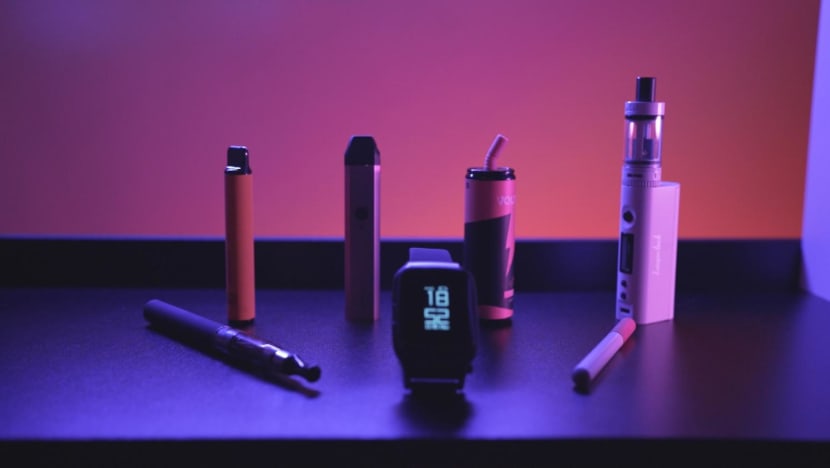Commentary: Is it time for vaping cessation programmes in Singapore?
Some vapers today have never smoked a cigarette. Perhaps it’s time to talk about helping vapers quit too, says smoking cessation counsellor Sean Ang.

At the moment, there are no clear vaping cessation guidelines for smoking cessation counsellors. (Photo: iStock/whitebalance.oatt)
SINGAPORE: In my 13-year career as a pharmacist providing smoking cessation therapy, I was astonished one day to receive a request from a primary school to counsel students who had been caught smoking, with the youngest being just 10 years old.
There were no guidelines on how to manage smokers that young, so my team had to use our experience and adapt our methods to guide the child. Over the years, I observed that adults and children were not seeing me just for cigarette smoking, but also for vaping.
Today, I work with some vapers who have never smoked a cigarette in their life and don’t know how it feels like to light up a cigarette. Though vaping is illegal in Singapore, vapers who seek professional help to quit are not penalised. The few who voluntarily come forward are concerned about their health, but the majority do not seem as worried about the health effects compared to smoking cigarettes.
A September 2022 Milieu survey showed illicit vaping to be on the rise in Singapore, with 4.3 per cent of adults using alternative products. In 2022, 4,916 people were caught for vaping, compared to 1,266 in 2020.
With the changing times, is it now time to talk about vaping cessation?
MORE ART THAN SCIENCE AT THIS POINT
At the moment, there are no clear vaping cessation guidelines for smoking cessation counsellors.
In Singapore, clinical practice guidelines on treating tobacco use and dependence were last updated in 2013 then withdrawn in 2018 (after 5 years, like most clinical practice guidelines). New (and existing) smoking cessation counsellors have nothing else to refer to except those guidelines to guide our practice. It is time for an update.
At this point, vaping cessation is more art than science. There isn’t any clear research-backed protocol to help someone quit vaping.
While vapers are attracted to different things compared to smoking (such as the flavours or discreteness of the device), the barriers to quitting smoking and vaping are relatively similar. These include social pressure, stress, nicotine withdrawal symptoms and the physical habit of handling a vaping device.
Thus, smoking cessation counsellors try their best to adapt their methods from existing smoking cessation practices.
While not every client requires Nicotine Replacement Therapy (NRT) to quit smoking or vaping, there also isn’t any NRT product that specifically caters to vaping. Similarly, we use our experience and understanding of the products to align their use with the nicotine consumption patterns of vapers who want to quit.
TOO MUCH VARIABILITY IN VAPING DEVICES AND ACCESSORIES
One of the greatest benefits of NRT, if used correctly, is its ability to manage the physiological withdrawal effects of nicotine.
To determine the correct dosage and regimen for prescribing NRT, pharmacists take into consideration the smoker’s smoking pattern, number of cigarettes the smoker smokes per day and the amount of nicotine inside each cigarette.
At the moment, there is too much variability and unknowns about the ingredients within each vaping pod. Since there is no regulation and smuggled vape products may not carry accurate (if any) labelling of composition or source, it makes it difficult for healthcare professionals to confidently know what exactly is inside those pods and how to recommend a proper regimen to help a vaper quit.

There are workarounds, but that takes a much longer time and can demoralise vapers who are engaging in the quitting process.
THE END GOAL IS TO BE NICOTINE-FREE
The end goal of any therapy is to be nicotine-free, not just smoke free. When a smoker says “I quit smoking” through vaping, they might mean “I quit cigarette smoking but changed to vaping”.
While non-combustible alternatives result in less toxins being produced, it is important to note that we still do not fully understand the components produced by vaping devices. And there is still nicotine involved.
Any product that contains nicotine is definitely not risk-free. Nicotine is well-documented as a highly addictive drug that increases the user’s blood pressure and heart rate and causes the narrowing of blood vessels. It also alters the way the brain functions and triggers strong cravings for the drug.
Combustible products, like cigarettes, are the most harmful as thousands more toxic chemicals are produced when tobacco burns. This greatly increases the smoker’s risk of lung cancer, chronic obstructive pulmonary disease and heart diseases.
On the other end of the spectrum, NRTs like gums and lozenges are not risk-free, but they are seen as less harmful and have been shown to be somewhat effective when used together with non-pharmaceutical interventions.
It is the hope of all smoking cessation counsellors to guide our clients to be nicotine-free.
VAPING CESSATION A CRUCIAL STEP
While a very select group of smokers may benefit from alternatives, there is always the worry about how to prevent access of these devices to non-smokers and youth.
Countries have adopted different models so far. Countries like Singapore and Thailand have completely banned vaping, but that has not stopped people from picking up vaping.
New Zealand, with a goal to become smoke-free by 2025, said it saw the potential of vaping as a way for smokers to quit. But with 20 per cent of youths vaping at least once a day according to a 2021 Asthma and Respiratory Foundation NZ survey, New Zealand announced earlier in June it would ban disposable vapes and catchy flavour names like “strawberry jelly donut”.
Australia recently banned non-prescription vaping products, including non-nicotine vapes. This means that access to vaping products must come through a doctor’s prescription and a registered pharmacy.
In the coming years, it is worth observing how these plans work out. Do these countries plan to assist vapers to eventually quit or are they going to “settle” for a nation of vapers? Have they developed any successful vaping cessation models that can be adapted in Singapore?
Whether a country chooses to legalise and regulate vaping or not, what is clear is that those who find a way to vape still risk getting addicted and other health issues. Going beyond smoking cessation to vaping cessation is needed to help people become nicotine-free.
Sean Ang is a smoking cessation counsellor and pharmacist, Success Alliance Enrichment.




















